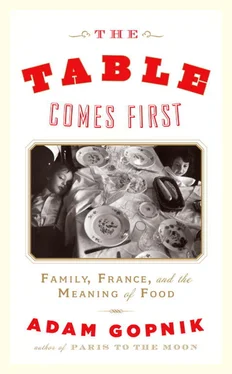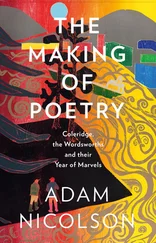Is this not the way big change often happens in all the arts? A composite, hybrid, open-ended, and eclectic thing, is soon treated as though it were a closed grammar, systematic and finished, only to be revealed later to have been a splendid mess all along. (Jackson Pollock’s spatters and pourings only latterly assume the utter precision and harmony we are directed to observe in them; the chaos one beholds on first glance is not entirely or even mostly an illusion. It was part of the intention.) It is the job of artists, including cooks and painters, to make whatever they can of whatever matter lies at hand. Then it is the job of critics to pretend that what looks like chaos is really closed order. (Clement Greenberg, the American art critic, had to take Pollock’s spatters and pourings, applied intuitively, and make them look like a logical culmination of everything that had ever happened in painting.) And then it falls to scholars later on to show that what looks closed was really just as chaotic as it first seemed: that American painting, or French cooking, is a mix of sixteen different things and eighteen different impulses, and anyway, was not the same in 1808 as it was in 1819. (This gives generations of critics and scholars work and keeps us off the streets, leaving the next generation of cooks and artists to do their work in relative peace.)
Yet the story of the birth of the French restaurant cannot be well told without the twin story of its Sancho Panza, the French café. The history of the café and the restaurant are no less intertwined than the history of the bed and the table; both entanglements represent a passage subtle and not always easily traced, then or now. In the best study of that history, From Taverns to Bistros: The History of Cafés , a French scholar named Luc Bihl-Willette identifies at least six distinct features that separated the restaurant from the café, though some seem more metaphysical than concrete.
It does seem sure that the modern café was born by government decree. One of the first laws made by the National Assembly after the revolution was one passed in 1789 that simply made it legal to sell coffee and wine and spirits in the same place—for the first time a drinking shop, where alcohol was sold, could be a place where other things to ingest were sold as well. We have been conditioned by Edmund Burke and his followers to think of the French Revolution as only a scary, top-heavy Utopian folly, and forget that it had its libertarian aspects, too. For the moderate Girondins, economic liberty was a crucial part of revolutionary liberty; Adam Smith was a new god France should worship. Monopoly was the enemy. Where, before the revolution, the selling and serving of food was bound around by archaic rites and privileges—only certain guilds could make breads; others pastries; still others sell tea and coffee; these aristocrats had the monopoly on salt, those on molasses—the revolution deregulated all that, and allowed, with modest momentousness, the neighborhood café, and, soon, the ordinary restaurant, to sell spirits and caffeine at the same place and time.
This helped the restaurant to become what it was and is. First, of course, by encouraging the entrepreneur, but also by mixing up the goods, and particularly by mixing up the two liquids of coffee and wine. For modern restaurant cooking is first and foremost a boat that, as in a Saul Steinberg drawing, steams its way downriver from the thousand dreamy islands of alcohol to the wide beckoning current of caffeine, from the stress-busting drink to the reawakening demitasse. A modern French meal not including both (even if the caffeine sometimes takes the degenerate form of tea, and the alcohol of spirits) is impossible to imagine. Dinner with water is dinner for prisoners. A modern meal is a drama unfolding between the Opening Drink and the Concluding Coffee, with the several acts passing between the libations.
And, without strong coffee and red wine, it isn’t possible to have good restaurants. Though it is hard to tell the restaurant from the café in following the restaurant’s semi-occult history, a case can be made that the café was the more original of the two inventions, or at least the more singular: around 1900, there were thirty thousand cafés in Paris, and fewer than six thousand in London—and it is hard to know how many of those in London were true cafés, and how many mere tea shops. On the other hand, when it came to the “drinking shops,” early bars, there was one for each one thousand potential drinkers in London, eleven to one thousand in Paris. The café was a civilizing institution, whose name guaranteed, or suggested, a genuine ward against alcoholism. The grand café of the Paris boulevards, like the proper restaurant, was always a source of wonder to English people, as it was to Americans.
Yet though joined at the hip, the temperamental difference between the two was real. The restaurant belongs to its cook. You come to eat, and though, as Brillat-Savarin saw, anyone can eat there, still you come to eat. Four pistoles are not nothing. The café, though, belongs to its habitués, and pleasure can be rented for the price of a coffee. We do not all feel equally at home within it; the newcomer to the quartier gets uneasy looks from the chess players at their usual table. But at the ritzy restaurant the awkwardness of the nouveau riche who has money in his pocket though not yet the rules of conduct graven in his heart is part of the comedy (and pathos) of urban modernity. (In Chaplin’s early masterpiece The Immigrant , Charlie as a recently arrived Jew knows some of the rules of the new American grand café—that you applaud when the music ends—but not others that don’t apply back where he comes from: for instance, that you should not ever, under any circumstances, eat with your knife.)
That the double presence of coffee and wine is necessary to “force” the restaurant, as the seeded underbrush is necessary to force the trees, is made plain when you see what happens in places—Ireland and England—where you drink your drink in one place and take your coffee in another: it’s a recipe for alcoholism, bad coffee, and a weak restaurant culture. (It was only after the proliferation of the espresso bar and the wine bar that London cooking began, thirty years ago, to become first rate.)
French cooking was made not merely in the space between caffeine and alcohol but in the simultaneous presence of both, thus blending, in sequence, the two drugs by which modern people shape their lives. Good food takes place in the head space between them. Most modern people use these drugs in some guise at one dose or another, but some of the primacy of Paris as a restaurant town surely has to do with its first having perfected the proportions and the form of each one. Modern life is regulated by these drugs, morning to night—one speeding us up, and one slowing us down. (The rock-and-roll-age equivalents, cocaine and pot, do the same work for another generation—do it more hysterically, but do the same work.) The British variants, tea and whisky or beer, are separated, by tradition and perhaps by necessity, in space and time: the four o’clock tearoom and the ten o’clock pub. (In the American diner, the two shaping drugs are caffeine and sugar—a cup of joe and a piece of pie.)
The decree of 1789 not only provided the French restaurant meal its fluids; it gave it its form. It was then that the system of alcohol began—fortified wines began to be drunk at the end of meals rather than right through. The wine began to be rated, blossoming into the greatest triumph of the French genius for systematization, the classification of Bordeaux in 1855. None of this happened quickly. The evidence for the introduction of the trou normand , the shot of spirits in between courses, for instance, is very shaky until our own time. But everyone noted that it was a new thing in France to drink sweetened coffee at night, at the end of meals, as a stimulant and digestif.
Читать дальше












